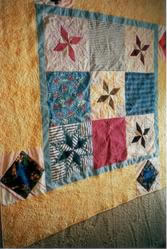 0
0

"Life Reflections" by Deborah Sylvester
Many quilters often wonder how their favorite quilting mentors became interested in the art of quilting and what inspires them. Lilo, the QuiltShowWizard, caught up with Deborah Sylvester in Houston and had the chance to sit down and ask Deborah a few questions about her quilting career. Interestingly enough, the journey for Deborah has similar threads (no pun intended) to that of many quilting fanatics.
Deborah’s husband of 23 years, a United States Marine with whom she has had the joy of parenting 3 children, was stationed in Virginia Beach, Virginia, USA. At that time she began watching Alex on Simply Quilts. On one particular program, the pattern demonstrated was Friendship Star. Deborah thought to herself, “I’d like to make this pattern,” so she gathered all of the necessary supplies and completed two blocks. She became frustrated because they didn’t match. Unwilling to give up so early, she went to her local quilt shop for assistance and advice and learned about the necessary quarter-inch foot on the sewing machine.
A short time later, Deborah’s family moved to Louisiana, where she joined a local quilt guild and learned a great deal more about her new found hobby. After attending the Houston show in 1998 and taking classes, she was ready to enter her first quilt in the Houston show exactly one year later, in 1999.
Initially Deborah’s work was in the traditional vein, but she soon learned she could not be as accurate as she desired. She had always wanted to try her hand at the more artistic quilts, and ironically (or as a matter of fate) met Hollis Chatelain in the elevator while at that same 1999 show in Houston. She and Hollis chatted, and Deborah subsequently began taking instruction from Hollis, who quickly became her mentor. Deborah proved to be a quick learner - she had her first gallery show while stationed with her husband in North Carolina. For that particular show, she was required to create 6 pieces in 6 months - no small feat, even for the most accomplished artist.
Deborah’s studio at Edwards Air Force Base, California, was in her laundry room. She put the cutting board atop the washer and dryer. She says that most military spouses who are also artists have to be very creative to find space in which to work. This is further proof of the old adage (as if more is needed) that “where there is a will, there is a way.”
Deborah’s style of work is fabric collage, which is hundreds of tiny pieces of fabric glued to the surface, as a painter would use paint. She has been evolving with this artistic style for 10 years. Deborah purposely obscures the ethnicity of her subjects. She says, “We all have the same colors in our skin, just different amounts of those colors.” She hopes the viewer sees what they imagine.
Deborah’s procedure differs somewhat from what one might expect in that she purchases fabric for the skin tone of her planned subjects, not the pattern of the quilt. Once she has accomplished purchasing the fabric, she begins with a line drawing and then enlarges it. She also stays very focused, only working on one piece of art at a time.
Deborah currently lives in the Pacific Northwest with her family and stays busy exploring and creating.




 How do I look?
How do I look?




.jpg)


